
Fotoreproductie van een schilderij van twee herders en een kudde schapen en koeien door Constant Troyon before 1863
0:00
0:00
Dimensions: height 263 mm, width 357 mm
Copyright: Rijks Museum: Open Domain
Curator: This is an albumen print dating from before 1863, reproducing a painting by Constant Troyon, known for his rural scenes. It depicts two herders with a drove of sheep and cattle on a dusty path. Editor: There’s a sense of quiet here, a stillness emphasized by the muted tones of the albumen print. The composition feels very classical, almost staged, like a carefully arranged tableau. Curator: Absolutely. Consider how Troyon and others engaged with genre painting. The rural idyll became a loaded site, often romanticizing agrarian life while masking the realities of class and labor. Whose vision of "the pastoral" are we seeing? How does this representation serve dominant power structures? Editor: The iconography, though, suggests a harmony with nature. The gentle curves of the sheep, the protective stance of the herders, the trees offering shade – they create a powerful symbol of communal living and stewardship, echoing archetypal themes of pastoral care that reach far back into history. Curator: But the ‘naturalness’ of this scene is constructed. Photography at this time was being used as a powerful tool. The act of reproducing a painting into a photograph… that adds another layer of meaning, another step of mediation from what is actually there and real. We are two degrees of separation away. Editor: True, and yet this photograph, as a copy, still retains its power as an image. The very act of documenting—in this case, a painting—gives it a sense of immortality, of continuing relevance. Consider the use of albumen as a medium. This photographic technique heightens the softness of the light and shadow creating a nostalgic effect and drawing you into the pastoral landscape. Curator: I agree with that tension between idyllic representation and socio-economic critique. It’s a reminder that images, no matter how beautiful, are never neutral. They always speak from a specific point of view. Editor: Ultimately, by looking at what the image signifies through repeated symbols we can find commonality with human expression that has continued throughout generations.
Comments
No comments
Be the first to comment and join the conversation on the ultimate creative platform.













